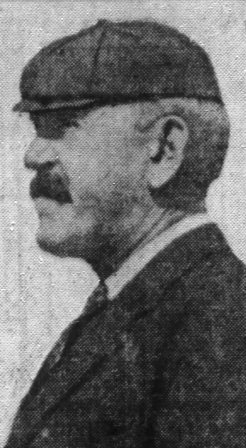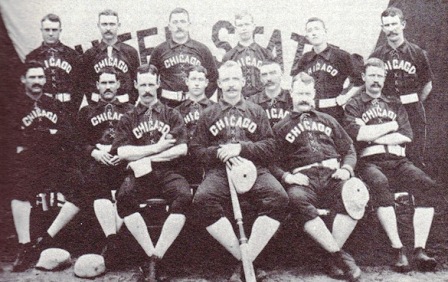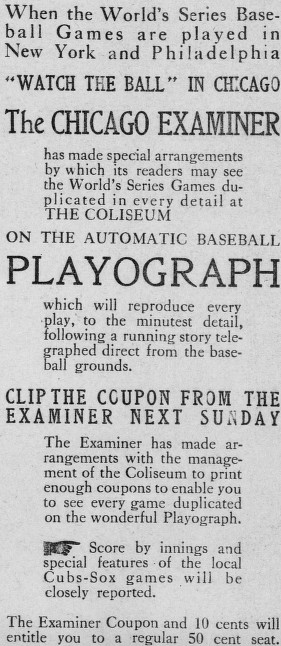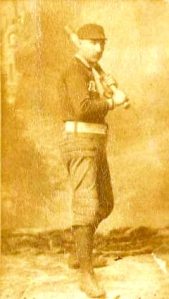On April 7, 1901, The San Francisco Call reported that John F. “Jack” Sheridan had accepted an offer from President Ban Johnson to continue working as an umpire in the American League—which operated as a minor league the previous season. The paper said “The National League also made a bid for his services. He will receive $400 a month and expenses.” It was said to be “the largest salary ever paid to an umpire.”
Sheridan was a former player, a second baseman and outfielder, who played for several San Francisco teams in the California League, including stints with the Haverlys from 1883-85. He went East in 1885 and appeared in six games for the Chattanooga Lookouts in the Southern league, and that same season began working as an umpire.

Jack Sheridan
Years later, Mique Fisher, long-time California and Pacific Coast League manager and executive told The (Spokane) Spokesman-Review that Sheridan was signed by the Lookouts after he “sold himself to Chattanooga through a glowing personal description of his own ability,” but Fisher said:
“Sheridan couldn’t field a ball with a fish net or hit one with a tennis racket. When the Chattanooga manager saw Sheridan in action, he swore out a warrant charging him with obtaining money fraudulently. Sheridan had to work out the expense advance in a cigarette factory.”
He worked as an umpire in the Southern League (1885, ‘93), the California League (1886-89, ’91), the Players League (1890), the National League (1892, ’96-97), and the Western/American League (1894-95, 1898-1900).
The best-paid umpire in the game, who was also a San Jose undertaker during the off-season, traveled from his California home to Chicago in early April of 1901, but a detour in Missouri nearly cost him his job.
The Chicago Tribune said Sheridan left the train “and was taken into custody on account of his strange actions.” The Fort Wayne Sentinel said among the “strange actions” Sheridan “donned his uniform and started to umpire an imaginary game in the middle of the street.”
Johnson sent fellow American League Umpire “Pongo” Joe Cantillon to Missouri to get Sheridan released and accompany him to Chicago. Sheridan was admitted to St. Elizabeth Hospital. The Tribune said he was suffering from “nervous prostration,’ while The Cincinnati Enquirer said the league president said Sheridan was “on a protracted drunk.”
The day after he was admitted to the hospital two friends were given permission to take Sheridan out for a walk, The Chicago Inter Ocean said:
“As they reached Milwaukee Avenue and Division Street, a (street) car whirled by, and Sheridan swung himself on the rear coach. His friends yelled in vain to the conductor to stop the train, and lost sight of Sheridan.
“They at once notified the police department to look out for Sheridan…Detective Fitzgerald found Sheridan wandering aimlessly on Jackson Boulevard near Wabash…Sheridan did not know where he was, nor could he tell where he had been since escaping from his friends.”
As Sheridan waited to appear in court to determine whether he was insane, newspapers speculated that Johnson would replace the umpire with either former player Warren “Hick” Carpenter or former Western and National League umpire Al Manassau—Manassau was appointed to the American League staff two days before the season began.
Before he could be adjudicated insane Sheridan made a miraculous recovery just one week into the season. The San Jose Evening News said:
“Mrs. Sheridan, the mother of Jack Sheridan, the noted baseball umpire, has received a telegram from her son, who is in Chicago, stating that he has fully recovered from his derangement and that he could now continue with his contract.”
Sheridan was back on the field before the month of April of over. He was competent, served as the American League umpires “chief of staff,” and umpired in four World Series (1905, 07, 08 and 10); he was also selected, along with National League umpire Bill Klem, to join the Chicago White Sox and New York Giants on their world tour after the 1913 season.
But he also demonstrated erratic behavior for the rest of his career.
Just a month after returning to the field The Sporting Life said “Sheridan became frantic and ran up and down the field like a crazy man,” after a disputed call at home plate in the bottom of the ninth of a May 31 game in Detroit between the Tigers and Baltimore Orioles, which led to Sheridan awarding the game to the Tigers by forfeit.
The Sporting Life’s Baltimore correspondent said Sheridan was “held by President Johnson as a competent man,” despite his “habits.”
He resigned on at least three occasions. After the 1905 and 07 seasons he said he was retiring to return to San Jose and become a full-time undertaker, only to return the following spring and in June of 1910, he abruptly quit minutes before a game in Washington, but returned within several weeks.
When Sheridan again took the field The Washington Post said he would “establish a precedent, as he will be the only major league umpire wearing glasses.”
Sheridan was also arrested in October of 1907 after a barroom brawl that began over a dispute over $120. The Associated Press said when police searched Sheridan he was carrying $2700. He was released from jail the following day after being fined $10.
On July 30, 1914, Sheridan called Ray Morgan of the Washington Senators out on a close play at first base in Detroit. The Washington Post said Morgan, who had slid, “came up with a handful of dirt and threw it on the ground at Sheridan’s feet…Sheridan evidently thought that Morgan intended to hit him, and did not even give the National’s second sacker time to put up his guard, but whaled away at his smaller opponent.”

Ray Morgan
Morgan punched Sheridan, and after both dugouts emptied, Sheridan was also punched by Washington’s Eddie Ainsmith. The disturbance spilled over to the stands with a few Washington players, including Morgan and Ainsmith, taking on Detroit fans before police restored order.
The Post said:
“This whole trouble, disgraceful to be sure, may be blamed directly on Jack Sheridan, the umpire, who has been at fault so many times this year. In the first place Sheridan has threatened to beat up several of the Washington players. Sheridan told (David “Mutt”) Williams and (Joe) Engel that he would punch them in the nose, the same as he had Morgan, if they did not do as he told them.”
Ban Johnson never took action against Sheridan for the incident in Detroit, but Morgan and Ainsmith drew suspensions from the league.
On August 1, 1914, The Associated Press reported that “The baseball players fraternity intends to take steps to have Umpire Jack Sheridan retired from service on grounds of incompetence.”
The incident, and dust up on August 12 with Jack Fournier of the White Sox inspired a poem from The Chicago Tribune’s Ring Lardner:
Making Night Hideous
Oft in the stilly night,
Ere slumber’s chain has bound me
Fond memory brings the sight
Of athletes crowding round me;
The scowls, the sneers
Of Jack Fourniers
And Morgans strike my vision;
I hear the barks
And rude remarks
That greet each close decision.
Thus in the stilly night,
Ere slumber’s chain has bound me,
I sometimes get tight up and fight
The chairs and tables round me.
At the end of the 1914 season, Sheridan returned to California. On October 31 The Associated Press reported that Sheridan would not be returning as an umpire:
“Sheridan will probably be retained as a sort of supervisor of umpires, spending his time roaming around the circuit.”
Just three days later Sheridan died of heart failure in San Jose at age 62—he was said to have suffered sunstroke during an August game and never fully recovered. Ban Johnson supported him to the end; just weeks before the umpire died the American League president told a reporter:
“I sincerely doubt if the baseball game will ever know another Jack Sheridan. He had all of the virtues of other arbiters, and none of their mistakes.”
Tags: Al Manassau, American League, Baltimore Orioles, Ban Johnson, Bill Klem, California League, Chattanooga Lookouts, Chicago White Sox, Detroit Tigers, Eddie Ainsmith, Hick Carpenter, Jack Fournier, Jack Sheridan, Joe Cantillon, Joe Engel, John McGraw, Mique Fisher, Mutt Williams, New York Giants, Pacific Coast League, Ray Morgan, Ring Lardner, Southern League, Washington Senators, World Series



















